|
Having trouble reading this email?
View it on your browser or download the PDF.

IN THIS ISSUE
 |
The Decommissioning of Nuclear Reactors and Related Environmental Consequences
Many of the world's nuclear reactors are aging toward the end of their designed operational lifespan, at a time when the
longstanding problem of radioactive nuclear waste disposal is still unsettled. The debate on this issue has intensified since
the March 2011 Fukushima nuclear accident in Japan.
|
Thematic Focus: Environmental governance, Resource efficiency, Harmful substances
The Decommissioning of Nuclear Reactors and Related Environmental Consequences
Why is this issue important?
A few decades ago, it was said that the debate on nuclear power had "reached an intensity unprecedented in the history of technology controversies"
(Kitschelt 1986). However, the controversy over nuclear power has resurfaced today with a similar gravity. Advocates point to nuclear power as a
much-needed energy source in an era of rising demand and the need to curb carbon emission levels, and of political instability in oil
exporting countries warranting greater energy independence. Opponents cite public health and safety risks, and environmental damage from processing,
transport and mining (uranium, as a fuel source). In regard to the issue of political instability, the spectre of sabotage and nuclear weapons is
raised. Insofar as unintentional occurrences are concerned, one needs only to look back on the March 2011 Fukushima nuclear accident in
Japan—a disaster of major proportions, and of which the effects are not yet fully understood.
Design and Distribution
Most nuclear power plants (NPPs) around the world were designed and constructed before the problem of how to eventually dismantle them had been solved,
or was even seriously considered. NPPs were initially designed to function for a term of 30 to 40 years with some granted a 20-year extension to 60 years.
Newer plants are now designed to operate for up to 60 years. Notably, extended operating lives are likely to generate more irradiated hardware.
Moreover, prospective plans for new construction are on the rise, with a reported investment from China to acquire approximately
30 new reactors, and five planned plus 16 proposed in Central Europe.
|
Nuclear reactors are systems that initiate contained nuclear chain reactions, releasing energy in the form of heat when atoms
from nuclear fuel split one after another from absorption of neutrons. As a by-product of the fission process that occurs in the reactor
core, radioactive waste is produced. In dismantling, or decommissioning a reactor at the end of its operating life, special measures are
undertaken to protect humans and the environment from the radioactive materials generated.
|
Currently, there are nearly 150 reactors still operating that are over 30 years old, 13 of which are over 40 years old (IAEA 2011). These figures do not
include military and research reactors. In the coming years, many reactors will be scheduled for decommissioning due to their advanced age,
adding to the already large number of inactive reactors (Figure 1).
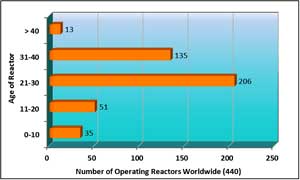
Full Size Image |
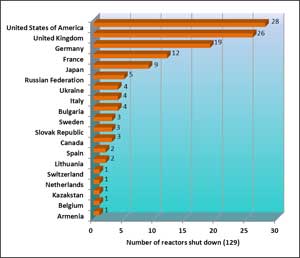
Full Size Image
|
|
Figure 1: Number of active nuclear power plant reactors by age category (left); number of reactors shut down by country (right) (IAEA 2011).
|
The Fukushima nuclear accident in Japan has further accelerated plans to shut down nuclear plants in several countries, with Germany and Switzerland
setting a timeline for the closure of all of their nuclear facilities (17 and five respectively). In Japan, 35 of the 54 reactors are currently
shutdown and awaiting permission to restart.
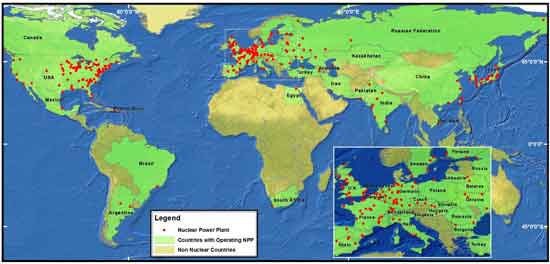
Full Size Image
Map 1: World distribution of NPPs (Data source: World Nuclear Association 2011. Map by UNEP.)
Research reactors are even more numerous. They are smaller than NPPs and used for research and training—they use less fuel and produce less waste.
The difficulties associated with decommissioning research reactors vary greatly, depending in part on the type and size of the reactors. Most
experience in decommissioning has been gained through that of research reactors. The majority of existing research reactors are now over 40 years
old and will soon be shut down. Figure 2 shows the number of permanently shut down research reactors by decade as they await decommissioning.
According to the World Nuclear Association (2011), in 2009 there were 250 operating research reactors, one under construction, 248 already shut down and
170 decommissioned.

Full Size Image |
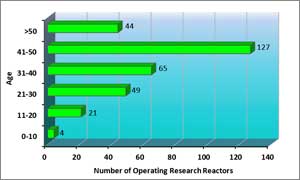
Full Size Image
|
|
Figure 2: Number of research reactors permanently shut down by decade awaiting decommissioning (left). Age of operating nuclear research
reactors (right) (data based on IAEA 2004).
|
Status of Decommissioning and Disposal
To decommission nuclear reactors, all the administrative and technical requirements that will allow some or all of the regulatory controls to be
removed from a facility must be implemented. Until now, only about seventeen of the 129 shut down nuclear power reactors have been fully decommissioned and
the sites removed from regulatory control (World Nuclear Association 2011). Other reactors have been placed into "safe-store" mode for a period of 40 to
60 years to reduce radioactivity before dismantling. Worldwide, three NPPs have been entombed—a procedure considered equivalent to creating a waste repository.
|
Decommissioning involves characterising, decontaminating and dismantling the reactors and the plant itself. This is followed by removing radioactive and
other wastes; cleaning up the site; and ensuring that potentially harmful radioactive materials are not released into the environment and that the
site complies with safety decommission, as set forth below
|
| Immediate Dismantling (DCON) | Safe Enclosure (SAFSTOR) | Entombment (Entomb) |
Equipment, buildings and parts of the facility and site that contain radioactive contaminants are decontaminated to a level that permits removal of regulatory control and
are dismantled shortly after the cessation of operations. Residual radioactive waste is treated, packaged, and removed to an appropriate waste storage or disposal site. |
The facility is placed and maintained in a safe stable condition until it is dismantled and decontaminated to levels that permit removal of regulatory controls.
During SAFSTOR, a facility is left intact with fuel being removed and radioactive liquids have been drained from systems and components and then processed.
Radionuclide decay occurs during the period of safe storage, thus reducing the quantity of contaminated and radioactive material. |
Radioactive structures, systems, and components are encased in a structurally long-lived substance such as concrete. The entombed structure is appropriately maintained and
continuous surveillance is carried out until the radionuclides decay to a level that permits removal of regulatory controls. |
|
Source: OECD (2002), Deloitte (2006) |
A final strategy for the decommissioning of the majority of sites has not yet been decided. The internationally preferred strategy for the decommissioning of the
majority of NPP sites is immediate dismantling. However, reviews indicate countries may employ several options including a combination option of immediate and deferred dismantling.
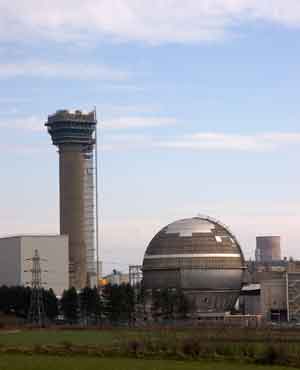
Dismantling of the tower of a military reactor. (Photo by Tim Duckett www.flickr.com ) |
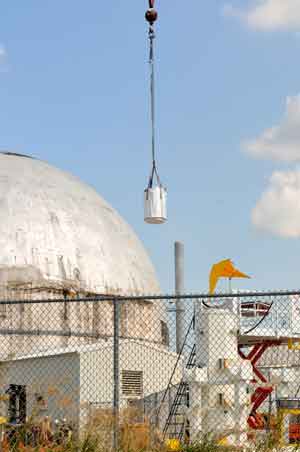
Removal of nuclear waste from a reactor of a military research programme site. (Photo by Argonne National Laboratory www.flickr.com) |
Nor is decommissioning (and the attendant hazards) restricted to just NPPs. Uranium mines, particle accelerators and nuclear vessels are also decommissioned. Decommissioning
nuclear-powered submarines, for example, also poses challenges. Each submarine produces an estimated 850 tonnes of low and intermediate level waste (LILW). A number of problems
make dismantling difficult: finding equipment for defuelling, identifying sites for the waste, acquiring sufficient funds, a lack of trained professionals, and disputes over
access and liability (Nilsen and others 1997, Webster 2003). As with NPPs, there is also the risk of radioactivity being released (Krylov and Pavlovski 2009). In the past, a nuclear
submarine's reactor was disposed off by extracting it from the vessel and sinking it in the sea (Olgaard 2006).
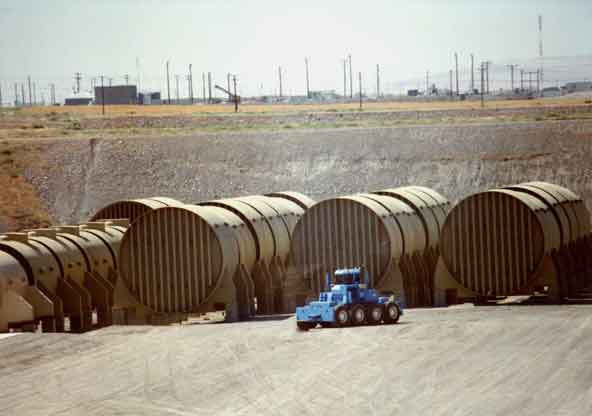
Reactors cut out of nuclear submarines and stored on the Hanford reservation DOE site in Washington State USA. (Photo by Fred Dawson www.flickr.com)
In 1991 approximately 200 decommissioned nuclear submarines existed in Russia. By 2003, half of these had actually been dismantled. However, many of the reactors from these
ships had been dumped in the sea or were still floating in buoys near the shipyards (Webster 2003). In the UK, a site for decommissioning out-of-service submarines has
not yet been selected, and fifteen submarines are currently awaiting dismantling or being prepared for "afloat storage" (Environment Agency UK 2011). Fears have been
raised over the creation of nuclear hot spots in oceans and seas (Aumento and others 2006).
Regulation and Responsibility
NPPs historically have been built and operated by state-owned utilities, and even in cases where NPPs have been privatized, governments may intervene or retain a particular role.
Government agencies and ministries are generally responsible for licensing requirements, promulgation of laws and regulations governing decommission activities
(to include the clean-up of decommission sites) and enforcement and compliance. Regulatory standards include such points as permissible radiation exposure for
workers and the public, and levels of radioactivity and discharges from sites. Governmental bodies are also responsible for setting national policy on shutdown of nuclear facilities.
With respect to the actual decommissioning, activities are carried out (and paid for) by the operator of the plant; however, in the event of operator default or non-performance,
this responsibility likely reverts to the regulating entity. In addition, certain countries have established a special body vested with long-term responsibility over decommissions.
International standards now require that a decommissioning plan be prepared at the design stage of all new NPPs, and that it be updated during the facility lifetime.
A final decommissioning plan must be developed two years before the planned shutdown (IAEA 2006). Decommissioning is a necessary but costly step that needs to be
considered in the planning and implementation of a nuclear project.
The Unquantifiable Costs of Decommissioning
The costs of decommissioning and waste disposal include the possibility of risks to public health, safety and the environment when not properly managed. Some unexpected
incidents have been reported during decommissioning, including releases of radioactive elements and fires and floods affecting the storage sites. The primary problems arising
from decommissioning relate to reprocessing and removing radioactive wastes for subsequent storage or disposal. One of the greatest dangers arising during equipment disassembly
is exposure to radiation, since protective safety barriers are dismantled and a large amount of radioactive substances can migrate outside the confines of the units (Bylkin and
others 2011). During the cutting up of the materials for decommissioning, the radioactivity is in a different form (dust and gas) than during the running of the NPP. This has
potential to create radioactivity leaks to the environment (Shimada and other 2010). Decommissioning one 1 000 MW reactor generates about 10,000 m3 of low and intermediate level
waste (LILW), much of which is concrete and other building materials containing small amounts of radioactive materials (CORWM 2006).
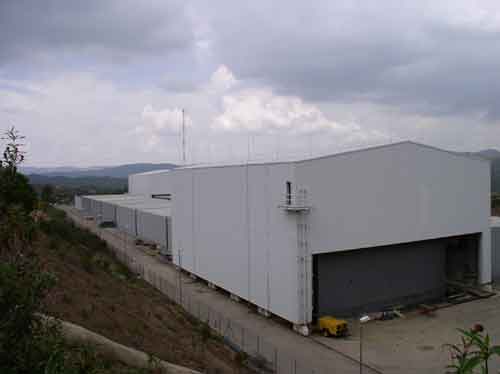
Low-level radioactive wastes in El Cabril disposal facility, Spain. (Photo by Fred Dawson www.flickr.com)
LILW is subdivided into two classes: LILW-SL (short-lived), which has a half-life of 30 years, and LILW-LL (long-lived), which has a half-life longer than 30 years or produces
too much heat to be classified as SL. In addition, some quantities of high-level waste (HLW) are also generated. HLW has a much longer half-life, generates tremendous heat and
requires isolation from the biosphere in deep underground repositories to ensure safety. The question of where these geological repositories should be located presents yet
another issue, and it remains controversial, especially in communities of proposed sites.
The Financial Costs of Decommissioning
As discussed above, clean-up of a decommission site is typically dictated by governmental regulation. It is satisfying the stringent regulations that prove to be a primary
cost driver for decommissioning and waste disposal. Reactor types and sizes, the number of reactors on an individual plant site, and labour costs are among the main factors
affecting costs. Mandated long-term site reviews and on-going monitoring and surveillance also drive up final costs, at times beyond original estimates. Further, non-human
driven cost factors must be accounted for including classification and type of waste (see above discussion on waste classifications), amount of waste produced, availability
of waste repositories for the particular type generated and special transport to those locations. Due to the variations in these cost components and the obvious fact that
shortcuts cannot be taken, significant differences between planned and actual costs have not been uncommon. As a result of these lessons, it has become highly recommended
practice to estimate and include decommissioning costs from the point of project inception, with review onward.
As another consequence of lessons learned, in some cases it is now mandated that a certain level of funds be set aside for decommissioning and waste disposal costs. Funds may
be accumulated through a variety of means including revenues from electricity customers, from taxes and imposition of fees, and in select cases by international donors. Given
the increasing pressures on governments today, and the projected growth of nuclear energy, a shift is also projected towards more private sector funding from investors
and lenders.
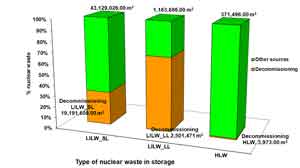
Percentage of waste from decommissioning activities compared to other sources. (Figures from newmdb site of the IAEA.)
Full Size Image |
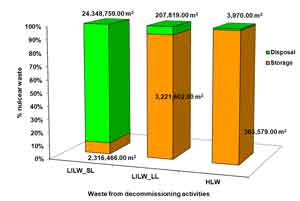
Percentage of nuclear waste by type in storage compared to in disposal. (Figures from newmdb site of the IAEA.)
Full Size Image
|
|
Figure 3: Percentage of nuclear waste from decommissioning and in storage and disposal.
|
What We Know Now, and Future Implications
1. Waste
A large number of sites will be required to store radioactive waste from decommissioned NPPs and other nuclear reactors over the long term. It is likely that additional
buildings and facilities to treat, package and store resultant wastes will need to be constructed to handle output from newly decommissioned reactors. In turn, the
infrastructure itself will also eventually have to be decommissioned. Decommissioning activities produce 68 per cent of LILW-LL waste, of which only seven per cent has
been disposed off to date (Figure 3).
Extensive research indicates that significant numbers of countries have plans in place for disposal of LILW-SL and some LILW-LL. However, most countries have no designated
sites for high-level waste due to political and public perceptions and long-term uncertainties surrounding the issue. The case of the United States illustrates these
difficulties in a developed country (Department of Energy USA 2011): problems associated with the selection of a site for the long-term disposal of high-level waste and
spent fuel have been ongoing for many years, leading to an increase in costs as solutions are considered; action is presently suspended. Countries facing greater economic
constraints will have even more serious difficulties dealing with radioactive waste disposal. In some cases, no waste management systems exist and the dismantling will be
deferred to a later date.
2. Limited information
The Nuclear Decommissioning Authority (2011) of the UK states that:
"One of the biggest difficulties we face is the limited information we have for a number of legacy facilities. For instance, some do not have detailed inventories of waste.
Some lack reliable design drawings. Many were one-off projects, built as experiments to test new approaches and ideas. Therefore the challenge is often not how to tackle a
particular task, but rather deciding what the task is. This is known as scoping."
3. Soil contamination
Based on past decommissioning experiences, it has been shown that the pattern and extent of soil contamination cannot be planned until late into the decommissioning process.
The boundary between the bedrock and soil deposits and the flow pathways in the soil will affect the direction and rate in which the radioactive material will be transported.
Soil testing below the buildings cannot be carried out until access has been made safe. Depending on the results of these tests, varying amounts of soil might have to be
removed, which cannot be determined until the decommissioning process is well underway. For example, in the case of the decommissioning of the Connecticut Yankee NPP in the
United States, the soil volume contaminated was higher than expected and 33 000 m3 of soil had to be removed, increasing the cost of the decommissioning. While the case cited
is an extreme example, this factor has to be taken into account. Decommissioning should be carried out in steps to avoid such problems disrupting the overall plans (EPRI 2011).
One of the possible consequences of soil contamination is the subsequent contamination of groundwater, either through migration of the contaminants through the soil to the
water table, or through the variation in water table height, since as the water rises, it can come into contact with contaminated soil. Reporting any leaks during the
lifetime of the NPP will enable decommissioning plans to be more precise (EPRI 2011).
4. Need for trained professionals
An increased number of trained professionals will be needed (IAEA 2005) and techniques need to be improved to ensure safer dismantling. In France, major progress has been made,
although no NPPs have yet been fully decommissioned despite the closure of ten NPPs since 1973. The dismantling of the Brennilis power station was meant to be a learning
experience to acquire technological knowledge to apply to other sites in France. Operations have been interrupted since 2007, however, due to security issues concerning
radioactivity levels and tracing wastes (EDF 2007). As some NPP sites will be placed in safe storage for up to 60 years, professionals will have to be trained now to
decommission them at a much later date, to avoid losing current knowledge about how to conduct the decommissioning.
The risks associated with radioactive leaks due to human errors might be higher during decommissioning. Indeed, the perception of risk is lower after high-activity inventory,
such as spent fuel, has been removed. In fact, the risk is not negligible due in part to the process being unregulated (Iguchi and Kato 2010).
5. Socio-economic impacts
Decommissioning NPPs affects local employment rates, the price of housing and land use. These impacts should be taken into account when selecting a strategy for decommissioning (IAEA 2005).
The release of sites for other uses may help to limit the social impacts, but other constraints still need to be considered. Negative public perception remains the most serious
challenge to opening radioactive waste repositories (Oldenburg and Birkholzer 2011).
6. Security
Once the spent fuel is removed from the reactors prior to decommissioning, the risks to the public and environment are relatively small. But where facilities are under
decommissioning, and in particular when they are placed in "safe-store" mode or entombed, site surveillance has to be maintained to protect the contents from theft and
malicious use. This is a costly factor that countries will need to take into account. Concerns exist about the risks associated with the possible use of nuclear devices
created from stolen nuclear material as well as sabotage of power stations (Bunn and Bunn 2008). These concerns have been proven to be real. In 1998 in Kinshasa, Congo,
for example, two reactor rods in a temporarily closed-down research station were stolen. Although one was later recovered in Italy, the other has never been recovered.
Security at the site is still considered highly unsatisfactory (McGreal 2006).
7. Cost
Since few NPPs have been fully decommissioned, the exact costs of accomplishing this phase are unknown (Ramana 2009). Estimates vary from 9% to 200% of the construction
costs (Lenzen 2008). Data are often not made available to the public owing to contractual arrangements, property rights and other reasons. Cost estimates are only accurate
from -5% to +15% (Laguardia 2006). A report estimating the cost of decommissioning a site in the United States shows that for some projects, documentation on the data used to
estimate costs is in fact missing (GAO 2010). Moreover, the projected trend toward increased private financing of NPPs can be expected to bring with it more extensive and
different types of reporting and documentation needs.
Additionally, it is important to note that recent worldwide economic instability could jeopardise these decommissioning funds, as well as premature or "on-time" NPP shutdowns;
thus, relevant operators and governments need to act. There are examples of funds for decommissioning plants in the United States losing 10% of their value during the
financial crises in 2008, resulting in delayed decommissioning plans (Thomas and Hall 2009).
8. CO2 production
Although in general nuclear energy generation does not produce any CO2, the full life-cycle of a nuclear power station is not "CO2-neutral". Decommissioning
is one of the processes that produces CO2, although studies vary greatly in estimating the amount produced. Based on several studies, it produces an estimated mean of 12g of CO2
emission per kilowatt hour (12 g CO2 e/kWh); while the mean emission level over the lifetime of a nuclear power plant is estimated to be 66 g CO2 e/kWh (Sovacool 2008).
While this cost varies according to technique and reactor type, the total energy required for decommissioning can be as much as 50% more than the energy needed for the original construction (Fleming 2007).
Conclusions
The decommissioning of a nuclear power plant is a large-scale organizational and technical process comparable in time, financial and labour resources to the building of the
unit. Decommissioning reactors will become a major operation over the next 50 years, with far-reaching implications including an increase in the production of radioactive waste,
health and security issues, socio-economic impacts and inevitable technical challenges. Given that the decommissioning process may take several decades, it is important that
plans are defined in advance. Detailed procedures and "best practice" policies are needed to minimize the danger posed to human health and the environment by decommissioning
nuclear facilities. Greater funding and international cooperation are required to share information and expertise on the decommissioning of nuclear reactors and submarines,
as aging NPPs are taken offline and nuclear submarines finally dismantled. Making best use of the Joint Convention on the Safety of the Spent Fuel Management and on the
Safety of Radioactive Waste Management is one of the steps to take in this direction.
References
Aumento F, Cristaldi M, & Zucchetti M 2006. Nuclear powered submarines as hazards to the marine environment,
Fresenius Environmental Bulletin, vol. 15 no. 9, pp. 1068-1075.
Bunn M and Bunn G 2008. Reducing the threat of nuclear theft and sabotage IAEA-SM-367/4/08, International Atomic Energy
Agency http://www.iaea.org/newscenter/features/nuclear_terrorism/bunn02.pdf (Accessed 4 July 2011).
Bylkin B K, Pereguda V I, Shaposhnikov V A, & Tikhonovskii V L 2011. Composition and structure of simulation models for
evaluating decommissions costs for nuclear power plant units. Atomic Energy, vol. 110 no. 20, pp. 77-81.
CORWM 2006. Managing our radioactive waste safely: CORWM's recommendation to Government. Committee on Radioactive Waste
Management Final Report, July 2006. London, UK. http://corwm.decc.gov.uk (Accessed 4 July 2011).
Deloitte Touche, Tohmatsu 2006. Nuclear Decommissioning and Waste: A Global Overview of Strategies and the Implications for the Future
Energy & Resources (May 2006). http://deloitte-ftp.fr/Lot-B-Energie-ressources/doc/NuclearDecommissioning.Mai06.pdf (Accessed 28 July 2011).
Department of Energy US 2011. Office of Civilian Radioactive Waste Management, http://www.ocrwm.doe.gov/ (Accessed 4 July 2011).
EDF 2007. La déconstruction de la Centrale de Brennilis Réunion de l'observatoire de démantèlement du vendredi
29 juin 2007 EDF press publication. http://energie.edf.com/fichiers/fckeditor/Commun/En_Direct_Centrales/Nucleaire/General/Deconstruction/documents/DP_Observatoire_juin2007.pdf (Accessed 4 July 2011).
Environment Agency UK, 2011. Nuclear submarine disposal, http://www.environment-agency.gov.uk/homeandleisure/110346.aspx (Accessed 4 July 2011).
EPRI 2011. Power Reactor Decommissioning Experience Technical. Report ID 1023456. Electric Power Research Institute (EPRI) Palo Alto, California, USA.
www.epri.com.
Fleming D 2007. The Lean Guide to Nuclear Energy: A Lifecycle in Trouble. The Lean Economy Connection, London. ISBN 9780955084928.
GAO 2010. Actions Needed to Develop High-Quality Cost Estimates for Construction and Environmental Cleanup Projects GAO-10-199
United States Government Accountability Office, http://www.gao.gov/new.items/d10199.pdf (Accessed 4 July 2011).
Kitschelt H P 1986. Political Opportunity and Political Protest: Anti-Nuclear Movements in Four Democracies.
British Journal of Political Science, Vol. 16, No. 1, 1986, p. 57 - 85.
Krylov A L & Pavlovski O A 2009. Modeling of consequences of hypothetical accidental radioactive contamination of gulfs and bays
in Murmansk region of Russian Federation, Radioprotection, Vol. 44, no. 5, pp 765 - 769.
IAEA 2004. Status of the decommissioning of nuclear facilities around the world STI/PUB/1201.
International Atomic Energy Agency, http://www-pub.iaea.org/MTCD/publications/PDF/Pub1201_web.pdf (Accessed 4 July 2011).
IAEA 2005. Selection of decommissioning strategies: Issues and factors IAEA-TECDOC-1478, International Atomic Energy Agency.
http://www-pub.iaea.org/MTCD/publications/PDF/TE_1478_web.pdf (Accessed 4 July 2011).
IAEA 2006. Decommissioning of Facilities Using Radioactive Material Safety Requirements IAEA Safety Standards Series No WS-R-5.
International Atomic Energy Agency. http://www-pub.iaea.org/MTCD/Publications/PDF/Pub1274_web.pdf (Accessed 4 July 2011).
IAEA 2011. Nuclear power plant information, International Atomic Energy Agency. http://www.iaea.org/cgi-bin/db.page.pl/pris.charts.htm
(Accessed 4 July 2011).
Iguchi Y & Kato M 2010. Risk-Informed Approach for the Regulation of Decommissioning of Nuclear Facilities. J. Eng. Gas Turbines Power, Vol 132, no 10, pp102910-102919.
Lenzen M 2008. Life cycle energy and greenhouse gas emissions of nuclear energy: A review. Energy Conversion and Management, vol. 49, no. 8,
pp 2178-2199.
Laguardia T 2006. Reasons for inconsistencies between estimated and actual decommissioning costs. In Proceedings of an International Conference Athens,
11-15 December 2006, ppp231-244. International Atomic Energy Agency. http://www-pub.iaea.org/MTCD/publications/PDF/Pub1299_web.pdf (Accessed 4 July 2011).
McGreal C 2006. Missing keys, holes in fence and a single padlock: welcome to Congo's nuclear plant guardian.co.uk, 23 November,
http://www.guardian.co.uk/world/2006/nov/23/congo.chrismcgreal (Accessed 15 June 2011).
Nilsen T, Kudrik I & Nikitin A, 1997. The Russian Northern Fleet Decommissioning of nuclear submarines Bellona Report 2:96.
http://spb.org.ru/bellona/ehome/russia/nfl/nfl6.htm (Accessed 4 July 2011).
Nuclear Decommissioning Authority 2011. The Nuclear Legacy, http://www.nda.gov.uk/aboutus/the-nuclear-legacy.cfm (Accessed 28 June 2011).
Newmdb site of International Atomic Energy Agency http://newmdb.iaea.org/datacentre-comparee.aspx.
OECD 2002. The Decommissioning and Dismantling of Nuclear Facilities: Status, Approaches, Challenges. Nuclear Energy Agency, Organisation for
Economic Co-Operation and Development (OECD). http://www.oecd-nea.org/rwm/reports/2002/3714-decommissioning.pdf (Accessed 28 July 2011).
Oldenburg C & Birkholzer J 2011. Comparative Assessment of Status and Opportunities for Carbon Dioxide Capture and Storage and Radioactive Waste
Disposal in North America, in Toth, F. (Ed) Geological Disposal of Carbon Dioixide and Radioactive Waste: a Comparative Assessment. Springer, Dordrecht, Netherlands, pp. 367 - 393.
Olgaard P 2006. Scientific and Technical Issues in the Management of Spent Fuel of Decommissioned Nuclear Submarines. NATO Science Series, Series II:
Mathematics, Physics and Chemistry, vol. 215, pp. 361-367.
Ramana M V 2009. Nuclear Power: Economic, Safety, Health, and Environmental Issues of Near-Term Technologies Annual Review of Environment and Resources, vol. 34, pp 127-152.
Sovacool B K 2008. Valuing the greenhouse gas emissions from nuclear power: A critical survey Energy Policy vol. 36 no. 8, pp 2950-2963.
Shimada T, Oshima S & Sukegawa T 2010. Development of Safety Assessment Code for Decommissioning of Nuclear Facilities (DecDose) Journal of Power and Energy Systems,
vol. 4 no 1, pp 40-53.
Thomas S and Hall D 2009. The Financial crisis and Nuclear Power. PSIRU, Business School, University of Greenwich, UK.
Webster P 2003. Haunted by red October, Science, vol. 301 no. 5639, pp. 1460-1463.
World Nuclear Association 2011. Decommissioning Nuclear Facilities http://www.world-nuclear.org/info/inf19.html (Accessed 4 July 2011).
Information is regularly scanned, screened, filtered, carefully edited, and published for
educational purposes. UNEP does not accept any liability or responsibility for the accuracy, completeness, or any other quality of information and
data published or linked to the site. Please read our privacy policy and
disclaimer for further information.
|

















